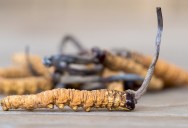One Of The World’s Most Expensive Natural Resources Is A Zombie Fungus That Costs $150,000 Per Kilogram
by Trisha Leigh

When you think of fungus, you probably don’t think of anything particularly valuable.
That said, scientists look at fungus a bit differently.
Cordyceps sinensis is a parasite that’s worth more than its weight in gold, and the fungus has medicinal value, but those who make money off harvesting and selling it are already facing threats from climate change and overharvesting.
Cordyceps sinensis is a “zombie fungus,” meaning they manipulate their host’s nervous system so as to maximize spore dispersal. Don’t worry. Even though it was the inspiration for The Last of Us, outside of Hollywood it has never parasitized a human. The species most at risk are its favorite host, the ghost moth (Hepilus fabricius).

Cordyceps sinensis is found at altitudes over 14,700 feet, largely in Bhutan, China, India, and Nepal. There, it invades the ghost moth in its caterpillar form and directs them to die in the soil’s surface.
After staying dormant over the winter, the spores burst out of the caterpillar’s head in the spring. They are long, stick-like protrusions that resemble worms, but are actually the fruiting body of the fungus.
Those float along, looking for a new caterpillar host in order to repeat the process.

The spores sell for around $150,000 per kilogram in China, and the global market tops $11 billion.
That said, harvesting it isn’t that easy. First, you have to be able to forage at an altitude that’s the equivalent of Everest’s Base Camp. Second, you have to beat off your fellow hunters in the process.
The harvesting window is small, just about two months, and every year the fruiting bodies are harder to find.
All of this is turning the fungus into a rare – and therefore expensive – resource.

Some companies are looking into exploring artificial Cordyceps, and believe it would have similar nutritional contents to the wild counterpart.
That doesn’t help the people who have cultivated the harvesting and sale of this fungus into a traditional practice over a thousand or more years, however.
I suppose all good things must come to an end, though.
Just ask the ghost moth.
Thought that was fascinating? Here’s another story you might like: Why You’ll Never See A Great White Shark In An Aquarium
Categories: ANIMALS, NATURE/SPACE
Tags: · Cordyceps sinensis, ghost moth larvae, natural resource, picture, science, single topic, the last of us, top, traditional medicine, zombie fungus
Trending on TwistedSifter

Parents Emotionally Manipulated Grandparent Into Babysitting For 5 Days, So They Took The Kids To Disney Without The Parents



